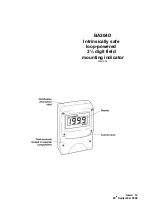
11
8. ACCESSORIES
8.1 Units of measurement and instrument
identification
All BA304D indicators are fitted with a blank label
around the liquid crystal display. This label can be
supplied printed with any units of measurement
and tag information specified at the time of
ordering. Alternatively the information may be
added on-site via an embossed strip, dry transfer
or even a permanent marker.
To gain access to the display label remove the
terminal cover by unscrewing the two 'A' screws
which will reveal two concealed 'D' screws.
Unscrew the four 'D' screws and carefully lift off the
front of the instrument enclosure - see Fig 4. Add
the required legend to the display label, or replace
with a new pre-printed label which is available from
BEKA associates.
The BA304D can also be supplied with a blank or
custom engraved stainless steel plate secured by
two screws to the side of the instrument enclosure.
This plate can accommodate:
1 row of 9 alphanumeric characters 10mm high
or 1 row of 11 alphanumeric characters 7mm high
or 2 rows of 18 alphanumeric characters 5mm high.
8.2 Internal Calibrator
The BA304D can be supplied with an optional
internal calibrator which simulates 4 and 20mA
input currents. This allows rapid calibration without
the need for external instruments or disconnection
from the 4/20mA input current, but it is not a
substitute for calibration with a traceable external
current source. Fig 6 shows the position of the
calibrator link which is located behind the
instrument control cover.
The plug-in root / linear link shown in Fig 6 must
always be in the root position when an internal
calibrator is fitted. An internal calibrator can not
be fitted to an instrument with a root extractor.
When using an internal calibrator, the following
procedure should be followed at any input current
between 4 and 20mA.
Step 1
Put the suppression / elevation, zero,
span and decimal point links in the
required position. Ensure that the root
/ linear link is in the root position.
Step
2
Put the calibrator link in the 4mA
position and adjust the indicator zero
potentiometer to give the required
display at 4mA.
Step 3
Put the calibrator link in the 20mA
position and adjust the indicator span
potentiometer to give the required
display at 20mA.
Step
4
Repeat steps 2 and 3 until both
calibration points are correct. The span
and zero controls are almost
independent so it should only be
necessary to repeat each adjustment
twice.
Step
5
Return the calibrator link to the
'indicate' position. The indicator will
now respond to the 4/20mA input
current with the revised calibration.
8.3 Root extractor
The BA304D can be supplied with a square root
extractor which enables the indicator to accurately
display the output from a differential flow meter in
linear engineering units between 10 and 100% of
full flow (4.16 to 20mA). The lineariser continues
to operate with reduced accuracy down to 2.5% of
maximum flow, alternatively clip-off can be
selected which will force the display to zero at
flows below 5% (4.04mA). The location of the clip-
off link is shown in Fig 7.
Fig 7 Location of root extractor clip-off link



































